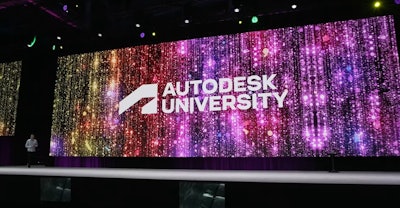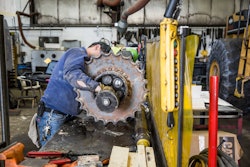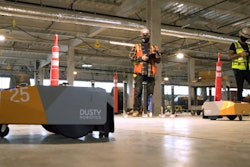
The main stage and sessions at Autodesk University 2022 were all about the San Rafael, Cal.-based software giant, but the exposition area was heavy with construction technology vendors with their own innovations to announce.
Offsite Construction Software
Manufacton, whose software addresses the unique solutions of off-site or modular builders, has launched new capabilities for multi-trade panelization. The Peachtree, Ga., software company delivers a software-as-a-service (SaaS) solution to manage construction materials, offsite production and onsite installation.
Also new are schedule-driven material demand forecasts and enhanced QA/QC workflows. The new workflow enables teams to manage QA/QC within Manufacton, eliminating the need for separate tracking sheets and saving teams time and resources since they are notified immediately when an issue arises. If a part is marked as failing, it must be fixed before the order is completed, which increases reliability and helps ensure compliance.
“The new QA-QC workflow enables a contractor to configure what forms you want to create and then tie those into production steps,” Manufacton CEO Raghi Iyenghar said. “If things fail, you can tie that feedback into the workflow to ensure they get resolved. A lot of our customers are very happy with how it is helping them take this to the next level.”
Apart from timely issue resolution, this quality data can be used for analysis and decision support.
“We have all of the data on everything that is happening through their workflow—all that then becomes available for our customers in the next generation of analytics,” Iyenghar said. “They can see how they are doing using our dashboarding, reporting and analytics.”
360 Data Capture and Robotics API from FARO
Personnel from 3D data capture leader FARO, including some worried about their return flights to the Lake Mary, Fla., during Hurricane Ian, were on hand to talk up their solution for construction as-builts for quality control, planning and preservation. New from the company as of the Autodesk University event was a 4D Construction Progress Management Solution, available on FARO's Sphere SaaS platform. Sphere provides a central location for users to capture, view, share and analyze reality capture data allowing construction and operation professionals to benefit from faster site updates, easier virtual collaboration and more reliable progress insights. The 4D Construction Progress Management Solution is expected to be released later this year.
The central component to the 4D Construction Progress Management Solution is the Sphere Viewer, which leverages a combination of high-end visualization technology, smart navigation, photogrammetry and artificial intelligence to create a comprehensive virtual jobsite. Developed by FARO's 360° reality capture and point cloud technology experts, the new viewer analyzes point clouds and 360° photos in a unified environment, removing reality capture data silos and enabling faster analysis.
In addition to the Sphere Viewer, the solution includes: VideoMode, which uses 360° videos to enable faster and easier site documentation, ProgressAI, which uses artificial intelligence to detect and report site progress, as well as a brand-new Robotics API. The new API allows robotic manufacturers to integrate and directly import reality captured data from robots straight into the virtual jobsite. The first robot to leverage the Robotics API will be Spot from Boston Dynamics.
Faro may be primarily known for its precision scanners, and in September announced their acquisition of GeoSlam, a provider of mobile scanning solutions with proprietary high-productivity simultaneous localization and mapping (SLAM) software to create 3D models for use in Digital Twin applications.
Last year, Faro acquired Holobuilder, which enables contractors and project stakeholders see 360-degree views of construction projects. This now seems to have been rationalized into the FARO offering as a whole.
“What we have new today is the speed from 360 video mode announced today,” Faro Director of Product Management Christian Claus said. “On the opposite side, we have the super precision with a stationary scanner and in the middle, a mobile scanner. We are uniquely positioned for the widest spectrum of capture options. Once we get these data types in, they are organized in the same coordinate system so users do not need to jump from one environment to another.”
At some point, FARO may evolve the application further into the transactional realm of progress reporting, but for now, the focus is on site and project visibility.
“The contractor gets one source of truth that can be manually adjusted, and is very useful for the contractor to manage that progress better,” Claus said. “When you go into the specific applications of what the contractor uses, that is up to them. But we are giving contractors the right degree of accuracy for each task. We want to accommodate the different levels of accuracy required. Our customers don’t have to scan the whole site with every data type—it can be workflow-driven based on the problem they are trying to solve.”
FARO has a strong presence among the ENR Top 400, but given the low entry-level price point for their 360-degree camera can be a fit for smaller generals, subcontractors and concrete contractors.
 HP SitePrint should be released to market in 2023.HP
HP SitePrint should be released to market in 2023.HP
Battlebots at Autodesk University
Hewlett-Packard demoed a field printing robot slated for release to market in 2023—setting them on a direct collision course with San Francisco-based incumbent Dusty Robotics.
HP SitePrint includes a Roomba-style robot and a tablet-based application to control the robot, which prints schematics for trade contractors to build to directly on the floor of the project. A cloud environment enables users to prepare a job to be printed. Site printers like this, and the Dusty Robotics offering, pair with a total station to eliminate the need for trade contractors to get on their hands and knees to map their project elements out on the floor, enabling more graceful and interlocked scheduling between trades and eliminating errors due to manual site layout.
While the HP demo team said their site printer would be available for early adopter customers in North America starting this month, the robot they had with them did not have functioning object avoidance capabilities, which they said was in fact operative on printers currently in the field.
Dusty Robotics CEO Tessa Lau was walking the event with her team and holding meetings with customers on site, and said this announcement by HP took her by surprise. But she was philosophical about this development.
“Imitation is the best form of flattery,” Lau said. “We have been in production since early 2020, and this move by HP is validation for us. The mission we have before us is to prepare contractors for increased productivity and automation. This is a huge opportunity, and there is room for multiple players.”
Lau started her company after watching a construction crew working on her own kitchen, manually laying the project out on the floor, and that their site printing robot had been going through regular evolution since launch, and will be part of a growing platform of robotic tools for contractors. The Dusty Robotics site printer is now used by 17 of the top 25 contractors, according to Lau.
“Site layout is usually done by the foreman—one of the highest paid employees on the site,” Lau said. “And mistakes cost even more money down the road. Three months after our prototype, we took the robot out to a customer site and printed something. Every month, we had another prototype on another customer site. We were not in a lab for years. We are constantly innovating, and ship new software once a month in response to things we learn from our customers.”
Customers are also innovating with the robot—Lau mentioned that on one job in the Midwest, the contractor is using the robot to print laydown areas for drywall so material can be staged at the site of deployment for lean inventory management. She said the newness of the technology, evolving nature of the use case, and the wide open possibilities, mean HP may want to choose a partner to resell and support their site printer very carefully. Sources at the company say HP has not identified its go-to-market approach yet but will likely find a company already selling technology into construction to represent their site printer.
“We are selling direct now,” Lau said. “We only have two salespeople, but the product is easy to sell. We also deal directly with service, support, upgrades and maintenance. We are intimately aware of what our customers’ experiences are with the robot, which is what you do lose with a channel.”
Lau said the company grew five fold over the previous year and is on track to have four times as many printers in the field by the time the HP SitePrint Robot is released to market.
What’s New at Newforma?
As Autodesk talked up the capabilities of its Forma data management platform to streamline data access across the distributed project team, Newforma, a similarly-named company that itself handles data and file sharing on large projects, rolled out new features for their ConstructEx SaaS platform for contractors and their core Newforma file sharing product which is primarily used by architects, engineers and owners to open projects up to their contractors, subs and stakeholders.
ConstructEx gets multi-language capabilities, starting with Spanish and German. A new app coming out next year will also bring to the table field productivity tools, consolidating several stand-alone ConstrectEx apps in a single, centralized offering.
“Right now, they use multiple applications including a Plan Pack that has Autodesk Sheets and document control,” Chief Marketing and Product Officer Slater Latour said. “We have a tasks app to track tasks and a capture app to grab field notes for later.
The flagship Newforma application is still a desktop or server-based product, but Latour said this is preferable for some of their government contractor customers who are hesitant to resort to SaaS in a public cloud. Newforma essentially connects documents provisioned and housed in different places—local drives, intranets and the cloud—and gives access to them according to project-specific permissions as needed to involve the far-flung members of a project team in decision-making and collaboration. This platform is still receiving heavy investment.
“We just built out a new infrastructure to connect to cloud document repositories,” Latour said. “If you came up navigating folder structures, this new tool presents cloud data right next to the other data—more intuitively than before.”
Latour seemed perplexed by the name Autodesk selected for their construction cloud, but stressed that the focus on interoperability is on target.
“The name thing is one thing,” Latour said. “But the better they make their APIs and outline for interoperability and extensibility—the better it is for us.”


















